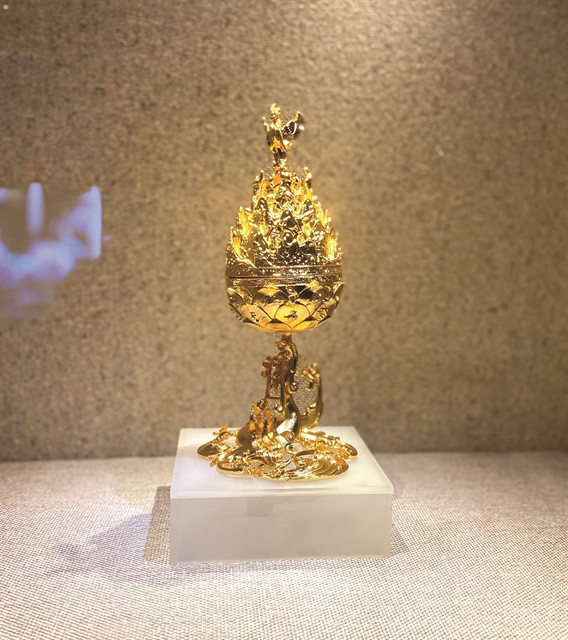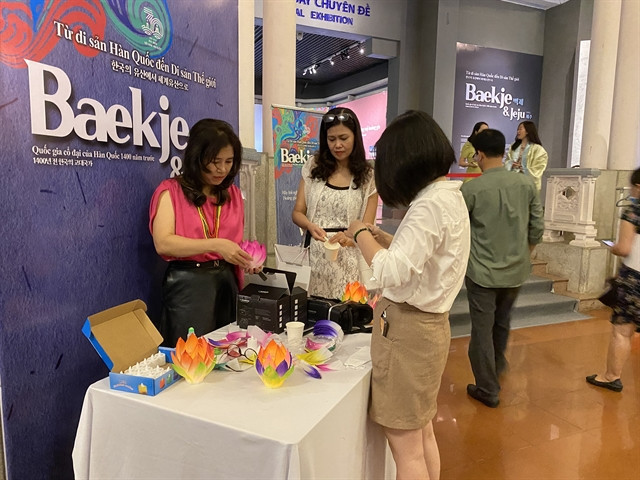Various valuable national treasures and antiques unearthed at the world heritage site Baekje, as well as images of Jeju Island, are on display at an exhibition in Hanoi.
Titled "Baekje & Jeju: from Korean Heritage to World Heritage", the event features the Baekje Heritage Site, symbolising Baekje's splendid culture 1,400 years ago, and Jeju Volcanic Island and Lava Cave, which show geological characteristics and the development process. The two localities were listed on the UNESCO World Heritage List in 2015 and 2007, respectively.
 |
| A replica of a gold gilded copper incense burner found at Neungsanri Pagoda in Baekje is displayed at the exhibition. — VNS Photos Lê Hương |
Nguyễn Văn Đoàn, director of the Việt Nam National Museum of History, said that Việt Nam and South Korea has a fairly similar culture and history; especially feudal dynasties in the two countries had a long-term relationship before Christ Era.
"The exhibition will help people in the two countries understand each other more, to go along side by side for the sustainable development and the prosperity of the two countries in the world culture community," he said.
 |
| A visitor takes photos of the exhibit. |
Gwiyoung Lee, director of Baekje World Heritage Centre, said Jeju Island bears the most significant development of geology and the forming of the earth's crust, while the Baekje culture relic complex hosts the flourishing culture of Baekje Reign 1,400 years ago.
"Vietnamese audience can see photos, videos of the sites and experience virtual visit to the sites at the exhibition," he said.
"Visitors can also try on traditional South Korean costumes, make lanterns, and taste Korean food and delicacies from Baekje," he said.
The exhibition includes four parts, namely the Space Life (Royal Citadel); Space of Faith (Buddhist Temples); Space of Afterlife (Royal Tombs) and Jeju Volcanic Island and Lava Tubes.
Three replica antiques are highlights of the exhibition, namely a golden decoration detail on King Muryeong's crown found in the king's coffin in an excavation in 1971; a gold gilded copper incense burner found at Neungsanri Pagoda in Baekje and a sarira pot found in a stone tower at Mireuk Pagoda.
 |
| Visitors will have a chance to try on traditional Korean costumes. |
The event, jointly organised by the museum, Baekje World Heritage Centre, South Korea Culture Centre and Jeju authorities, aims to celebrate the 30th anniversary of diplomatic ties between the two countries.
The exhibition will run till October 16 at the museum, 1 Tràng Tiền Street, Hoàn Kiếm District, Hà Nội.
Lantern making activity will take place on September 17 and 24, and October 1, 8 and 15.
The culinary experience will be available on September 24 and October 1.
Film screenings will be available on September 18 and 25, and on October 2, 9 and 16.
Baekje (18 BC to 660 AD) was an ancient kingdom that lasted for about 700 years, mainly in the central and southwest parts of the Korean Peninsula.
Baekje is divided into Hanseong (today's Seoul, 18 BC - 475) to Ungjin (today's Gongju, 475-538), and Sabi (today's Buyeo, 538-660) according to the location of the capital.
The Baekje Heritage Site, inscribed on the UNESCO World Heritage List in 2015, includes archaeological sites from Ungjin and Sabi periods.
 |
| Audiences can make traditional Korean lanterns at the event. |
The sites consist of royal palaces, temples, royal tombs, and an outer city wall. The Baekje Historic Area is valuable in that it is a representative heritage that shows the essence of Baekje culture and a place where you can vividly confirm the status of Baekje, which contributed to the exchange and formation of East Asian civilisation. — VNS